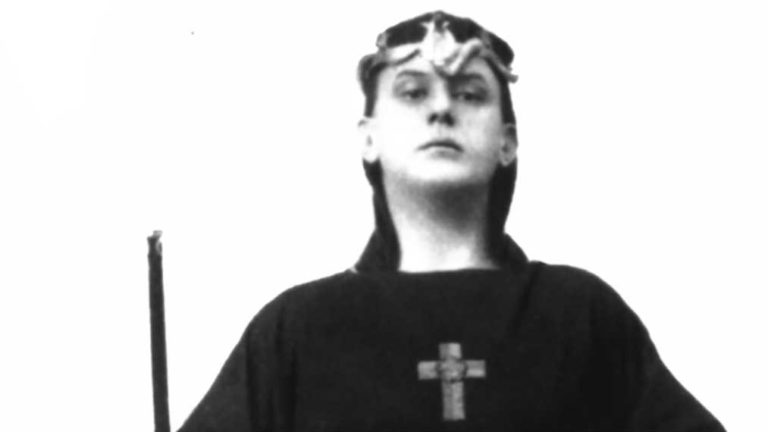The Many Faces of Wicca and Witchcraft

Forget your mid-century modern, sexy housewife witch — a submissive Hollywood sorceress who denies her powers for her mortal mate. She and her ilk, including the diabolical femme fatale, a temptress archetype, eternally scheming to lead good men to damnation (think Morgan le Fay of the King Arthur legends), are products of centuries of fantasy and propaganda — all facets of female “original sin” by default.
Other stereotypes, such as Shakespeare’s hags muttering over a bubbling cauldron, are equally fictitious, though likely derived from elderly “wise women” archetypes; village healers, counselors, and keepers of women’s’ secrets.
Today’s witch, or Wiccan, may appear as a cookie-baking British grandmother who, at Beltane, can be found dancing “skyclad” with her coven in the forest. You may also meet a feminist and environmental activist like Starhawk, author of the classic The Spiral Dance, a modern sourcebook on Goddess-based neopaganism. Or a young housewife and mother blogging about Wiccan parenting.

A classic mid-century femme fatale witch
In 1986, Wicca was legally recognized as an organized religion in the U.S. In Britain, ancient anti-witchcraft laws were struck from the books in 1951, officially ending centuries of fear, bloody persecution, and death.
As spirituality has gone mainstream, numbers for those identifying as Wiccans in the U.S. went from around 400,000 in 2008 to roughly 1.5 million in 2014. Younger generations of Wiccans reject stereotypes — many young converts embrace environmental and feminist activism, calling for a re-evaluation of the feminine, from the material to the sublime. According to Starhawk, the trend appeals to women seeking to reclaim sacred feminine power.
Wicca vs. Witchcraft
While Wicca is a religion with principles and observances, witchcraft is a practice of spellcasting, herbalism, and divination — individuals choose their own disciplines. A Wiccan can practice witchcraft, but a “witch,” or witchcraft practitioner, is not necessarily a Wiccan.
These traditions descend from paleolithic shamanic practices of ritual offerings and dance dedicated to a successful hunt. Evidence in the form of cave art and artifacts can be found in some form on every continent.
The feminine Goddess concept straddles Wiccan and witchcraft models — the ancient Greek Hecate in one form or another. She rules over magic, crossroads and thresholds, and the moon. She is the Goddess of the hedge, a symbol for passage from the material to subtle dimensions. In the ancient Roman novel, “The Golden Ass,” by Apuleius, Hecate says,
“I am mistress of all the elements and natural mother of all things. At my will, the planets of the air, the winds of the seas, and the silences of hell be disposed. Some call me Juno, others call me Queen Isis.”

The Magic Circle by John William Waterhouse
While there are multiple schools of Wicca and witchcraft, here is a sampling of some of the most well-known:
Wicca
Wicca is a religion based on nature, ceremonial magic, and with the exception of Dianic Wicca, worshiping masculine and feminine principles as Gods and Goddesses. Wicca is based on initiations, ear-whispered teaching, study, practice, and discipline. The final and highest initiations are high priest and priestess. Wicca as a combination of nature worship and witchcraft emerged in 1954 with the launch of the book “Witchcraft Today.”
- Gardnerian
Gerald Brousseau Gardner, author of “Witchcraft Today,” is seen by many as the father of modern Wicca. He was involved in the post-WWII occult community in England, along with occult authors Dion Fortune and Aleister Crowley. Gardner sought to preserve what he called the “old ways,” and revive nature-based pagan traditions.
- Dianic Wicca
A “neopagan” tradition, it only recognizes deities such as the Roman Diana (Goddess of the moon, the hunt, and nature) or the ubiquitous Triple-Goddess, Greek Hekate (magic, the moon’s phases, thresholds and crossroads, nocturnal creatures, newborns, and the dead) viewing them as aspects of a single, divine creative feminine principle.
- Seax-Wicca
In 1973, Raymond Buckland left the Gardnerian tradition and founded Seax-Wicca. Buckland eliminated initiations, degrees, and oaths and vows. He was inspired by Saxon paganism but did not claim to have recovered pre-Christian pagan forms. Seax-Wicca deities are from the classic Scandinavian traditions and include Odin as the masculine principle and Freya as the feminine. Seax-Wicca is known for being democratic — leaders are elected. The system also uses Saxon runes and can be practiced in solitary or within a group.
Witchcraft
- Kitchen Witchcraft
Kitchen witchcraft, sometimes called hedge, cottage, and green witchery, is dedicated to the hearth and home. Practical, home-based folklore and spells related to cooking and crafts, i.e. making talismans, are part and parcel of kitchen witchery. A practitioner may keep an alter or Goddess shrine near her stove, and have a garden dedicated to magical and medicinal plants and herbs. He or she may also plant and harvest by lunar cycles and produce herbal tinctures as medicine. Kitchen witches may be Wiccan, or simply practitioners.
- Stregheria
From Southern Europe, Stregheria traveled with Italian immigrants to the U.S. in the late 19th and 20th centuries. Practitioner Raven Grimassi says the tradition descends from Etruscan paganism, and has blended with folk traditions and Catholicism in the form of saint worship and petitioning. Stregheria is one of the oldest forms of European witchcraft — second in antiquity only to Greek witchcraft, dating back to Homer. Grimassi named her version the “Aridian” tradition, named for the folkloric Aradia, a Tuscan witch who taught protective magic and ritual to those oppressed and exploited by the Catholic church and aristocracy. Stregheria recognizes the pre-Christian Roman Diana, and Catholic saints are viewed as ancient pagan gods dressed up as Christian symbols. The tradition also honors ancestors and local land spirits.
Aleister Crowley: The Wickedest Writer in the World

Known as “the wickedest man in the world,” English occultist and author Aleister Crowley actively embraced and contributed to his own notoriety. He delighted in shaking up social status quos, and used his infamy to draw a veil over, and at the same time draw attention to his esoteric work.
Crowley (b. 1875) died in 1947, leaving 61 books, some published during his lifetime — others published posthumously in the 1970s, 80s and 90s. Crowley’s books enjoyed a revival, and Crowley himself achieved cult status during the expanding consciousness revolution beginning in the late 1960s.
Crowley was a prolific writer, and during his life wrote about the Qaballa, yoga, and the “Goetia,” attributed to the biblical King Solomon. He also penned commentaries on Thoth, “the Tarot of the Egyptians,” and the esoteric use of drugs to name but a few.
Crowley the Drug Fiend
The 1922 novel, “Diary of a Drug Fiend” was, according to Crowley, “A true story, rewritten to conceal personalities.” In his quest to understand the influence of different types of drugs on the mind, Crowley was captured by heroin, documenting that struggle in “Diary of a Drug Fiend.” He also experimented with and wrote about psychoactive substances, including absinthe (The Green Goddess, 1917), hashish (The Psychology of Hashish, 1909), and cocaine (Cocaine, 1917). Crowley also published “A Pharmaceutical Study of Cannabis Sativa” by E.P. Whineray in his March, 1909 issue of his journal The Equinox.
Ever in search of peak experiences, epiphanies, and absolute insight, Crowley advocated incorporating drug use into all magickal ceremonies, demonstrating his drive to experience expanded consciousness by any means necessary. He believed that the use of these substances would succeed where religion and science had failed to solve the rubric of the true nature of reality.




































